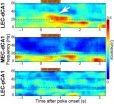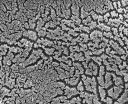(Press-News.org) Waves in your brain make smells stick to your memories and inner maps.
When I was a child I used to sit in my grandfather's workshop, playing with wood shavings. Freshly shaven wood has a distinct smell of childhood happiness, and whenever I get a whiff of that scent my brain immediately conjures up images of my grandfather at his working bench, the heat from the fireplace and the dog next to it.
Researchers at the Kavli Institute for Systems Neuroscience have recently discovered the process behind this phenomenon. The brain, it turns out, connects smells to memories through an associative process where neural networks are linked through synchronised brain waves of 20-40 Hz. The results are published in the latest edition of Nature.
– We all know that smell is connected to memories, Kei Igarashi, lead author, explains.– We know that neurons in different brain regions need to oscillate in synchrony for these regions to speak effectively to each other. Still, the relationship between interregional coupling and formation of memory traces has remained poorly understood. So we designed a task to investigate how odour-place representation evolved in the entorhinal and hippocampal region, to figure out whether learning depends on coupling of oscillatory networks.
Smell guides the way in maze
The researchers designed a maze for rats, where a rat would see a hole to poke its nose into. When poking into the hole, the rat was presented with one of two alternative smells. One smell told the rat that food would be found in the left food cup behind the rat. The other smell told it that there was food in the right cup. The rat would soon learn which smell would lead to a reward where. After three weeks of training, the rats chose correctly on more than 85% of the trials. In order to see what happened inside the brain during acquisition, 16 electrode pairs were inserted in the hippocampus and in different areas of the entorhinal cortex.
After the associations between smell and place were well established, the researchers could see a pattern of brain wave activity (the electrical signal from a large number of neurons) during retrieval.
Coherent brain activity evolves with learning
– Immediately after the rat is exposed to the smell there is a burst in activity of 20 Hz waves in a specific connection between an area in the entorhinal cortex, lateral entorhinal cortex (LEC), and an area in the hippocampus, distal CA1 (dCA1), while a similar strong response was not observed in other connections, Igarashi explains.
This coherence of 20 Hz activity in the LEC and dCA1 evolved in parallel with learning, with little coherence between these areas before training started. By the time the learning period was over, cells were phase locked to the oscillation and a large portion of the cells responded specifically to one or the other of the smell-odour pairs.
Long distance communication in brain mediated by waves
– This is not the first time we observe that the brain uses synchronised wave activity to establish network connections, Edvard Moser, director of the Kavli Institute for Systems Neuroscience says. – Both during encoding and retrieval of declarative memories there is an interaction between these areas mediated through gamma and theta oscillations. However, this is the first study to relate the development of a specific band of oscillations to memory performance in the hippocampus. Together, the evidence is now piling up and pointing in the direction of cortical oscillations as a general mechanism for mediating interactions among functionally specialised neurons in distributed brain circuits.
So, there you have it – the signals from your nose translate and connect to memories in an orchestrated symphony of signals in your head. Each of these memories connects to a location, pinpointed on your inner map. So when you feel a wave of reminiscence triggered by a fragrance, think about how waves created this connection in the first place.
INFORMATION:
Additional photo of Edvard Moser is found here:
https://www.flickr.com/photos/ntnumedicine/8240340199/in/set-72157627890835196
ARTICLE: Coordination of entorhinal-hippocampal ensemble activity during associative learning.
Tweet version: The brain connects smells to memories through a process where neural networks are linked via synchronised brain waves of 20-40 Hz.
Why your nose can be a pathfinder
Coordination of entorhinal-hippocampal ensemble activity during associative learning
2014-04-16
ELSE PRESS RELEASES FROM THIS DATE:
Rice U. study: Performance measures for CEOs vary greatly
2014-04-16
HOUSTON – (April 16, 2014) – As companies file their annual proxy statements with the U.S. Securities and Exchange Commission (SEC) this spring, a new study by Rice University and Cornell University shows just how S&P 500 companies have tied CEO compensation to performance. The study found large variations in the choice of performance measures, and the researchers said that companies tend to choose measures that are informative of CEO actions.
"On average, firms rely mostly on accounting-based performance measures, among which they put heavier weights on income measures, ...
Progress in the fight against quantum dissipation
2014-04-16
Scientists at Yale have confirmed a 50-year-old, previously untested theoretical prediction in physics and improved the energy storage time of a quantum switch by several orders of magnitude. They report their results in the April 17 issue of the journal Nature.
High-quality quantum switches are essential for the development of quantum computers and the quantum internet — innovations that would offer vastly greater information processing power and speed than classical (digital) computers, as well as more secure information transmission.
"Fighting dissipation is one ...
Why interest is crucial to your success
2014-04-16
DURHAM, N.C. -- Maintaining an interest in the goals you pursue can improve your work and reduce burnout, according to research from Duke University.
"Our research shows that interest is important in the process of pursuing goals. It allows us to perform at high levels without wearing out," said Paul O'Keefe, who conducted the studies as a doctoral student in Duke University's Department of Psychology & Neuroscience, along with associate professor Lisa Linnenbrink-Garcia. "This suggests that interest matters more than we suspected."
The studies, which appear online ...
Dartmouth-led study shows air temperature influenced African glacial movements
2014-04-16
Changes in air temperature, not precipitation, drove the expansion and contraction of glaciers in Africa's Rwenzori Mountains at the height of the last ice age, according to a Dartmouth-led study funded by the National Geographic Society and the National Science Foundation.
The results – along with a recent Dartmouth-led study that found air temperature also likely influenced the fluctuating size of South America's Quelccaya Ice Cap over the past millennium -- support many scientists' suspicions that today's tropical glaciers are rapidly shrinking primarily because of ...
Scientists unlock secrets of protein produced by disease-causing fungus
2014-04-16
SAN ANTONIO, Texas (April 16, 2014) — A team that includes scientists from the School of Medicine at The University of Texas Health Science Center at San Antonio, Johns Hopkins University and St. Mary's University reported the structure of a protein that helps a common fungus to infect the body.
The fungal pathogen Candida albicans causes yeast infections, diaper rashes and oral thrush, and is the most common fungal pathogen to infect humans. It can also cause a life-threatening infection of the blood called disseminated candidiasis.
"In this study, we determined the ...
Vanderbilt researchers discover how intestinal cells build nutrient-absorbing surface
2014-04-16
The "brush border" – a densely packed array of finger-like projections called microvilli – covers the surfaces of the cells that line our intestines.
Vanderbilt University researchers have now discovered how intestinal cells build this specialized structure, which is critical for absorbing nutrients and defending against pathogens. The findings, published April 10 in the journal Cell, reveal a role for adhesion molecules in brush border assembly and increase our understanding of intestinal pathologies associated with inherited and infectious diseases.
Pathogens that destroy ...
Surveillance colonoscopy recommendations for average-risk patients with 1 to 2 small polyps consistent with guidelines
2014-04-16
DOWNERS GROVE, Ill. – April 16, 2014 – According to a new study, endoscopists' recommendations for timing of surveillance colonoscopy in average-risk patients with one to two small polyps are consistent with guideline recommendations in about 90 percent of cases. This may be an appropriate target for quality indicators. This is the first multicenter endoscopic database study to quantify adherence to guidelines for timing of repeat colonoscopy after one to two small polyps are found during screening colonoscopy in average-risk patients. The study appears in the April issue ...
Scientists capture ultrafast snapshots of light-driven superconductivity
2014-04-16
A new study pins down a major factor behind the appearance of superconductivity—the ability to conduct electricity with 100 percent efficiency—in a promising copper-oxide material.
Scientists used carefully timed pairs of laser pulses at SLAC National Accelerator Laboratory's Linac Coherent Light Source (LCLS) to trigger superconductivity in the material and immediately take x-ray snapshots of its atomic and electronic structure as superconductivity emerged.
They discovered that so-called "charge stripes" of increased electrical charge melted away as superconductivity ...
Eavesdropping on brain cell chatter
2014-04-16
Everything we do — all of our movements, thoughts and feelings – are the result of neurons talking with one another, and recent studies have suggested that some of the conversations might not be all that private. Brain cells known as astrocytes may be listening in on, or even participating in, some of those discussions. But a new mouse study suggests that astrocytes might only be tuning in part of the time — specifically, when the neurons get really excited about something. This research, published in Neuron, was supported by the National Institute of Neurological Disorders ...
How kids' brain structures grow as memory develops
2014-04-16
Our ability to store memories improves during childhood, associated with structural changes in the hippocampus and its connections with prefrontal and parietal cortices. New research from UC Davis is exploring how these brain regions develop at this crucial time. Eventually, that could give insights into disorders that typically emerge in the transition into and during adolescence and affect memory, such as schizophrenia and depression.
Located deep in the middle of the brain, the hippocampus plays a key role in forming memories. It looks something like two curving fingers ...
LAST 30 PRESS RELEASES:
Anxiety and insomnia may lower natural killer cell count, potentially repressing immune function
How parasitic, asexual plants evolve and live
Research spotlight: A subset of patients with depression could benefit from anti-inflammatory treatment
New fully digital design paves the way for scalable probabilistic computing
Membrane electrode assembly design for high-efficiency anion exchange membrane water electrolysis
U.S. debt ceiling disputes show measurable impact on global crude oil markets
Climate extremes triggered rare coral disease and mass mortality on the Great Barrier Reef
Direct observation reveals “two-in-one” roles of plasma turbulence
Humans rank between meerkats and beavers in monogamy ‘league table’
US fossil reveals early mass-burial event and ancient microbial attack
Sedative choice could improve outcomes for breathing tube patients
New superconducting thin film for quantum computer chips
Simulations reveal protein "dynamin" constricts cell membranes by loosening its grip
Nearly 1 in 5 UK emergency department patients cared for in corridors/waiting rooms
Heavy energy drink intake may pose serious stroke risk, doctors warn
Violence against women and children among top health threats: New global study reveals disease burden far larger than previously estimated
Predicting who is at risk of developing type 1 diabetes, as new drugs now available
New gene-mapping method unlocks hidden drivers of cancer
Ocean current and seabed shape influence warm water circulation under ice shelves
Call to increase funding for ‘invisible’ Deaf victim-survivors of domestic abuse
University of Maryland School of Medicine names distinguished scientist and academic leader Gerald M. Wilson, PhD, as Chair of the Department of Biochemistry and Molecular Biology
Receptors in mammary glands make livestock and humans inviting hosts for avian flu
Icy hot plasmas
Treating adults with autism: Maryland Clinical Center offers national blueprint for care after pediatric transition
University of Phoenix College of Doctoral Studies releases white paper on reclaiming control to build workforce resilience
NCCN Summit seeks to improve care for veterans and first responders with cancer from line-of-duty exposure
ERC Consolidator Grant for soft robotics researcher
Dual-action arts and wellbeing program transforms dementia care
The global plastic waste trade contributes to coastal litter in importing countries, study shows
UT Dallas partners with Tech Mahindra on AI innovation
[Press-News.org] Why your nose can be a pathfinderCoordination of entorhinal-hippocampal ensemble activity during associative learning






